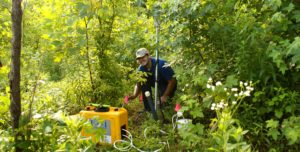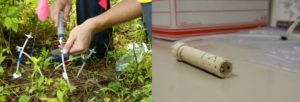
Smithsonian Environmental Research Center intern Chaz Rhodes samples gases in the soil with equipment he helped design and install. It’s part of a new long-term study seeking to untangle what drives changes in the methane budget in forest soils.
by Alison Haigh
When it comes to forests, most people think of soil as a static ingredient in a recipe for growing trees. But talk to any forest ecologist, soil scientist, or biogeochemist, and you’ll get a radically different idea about dirt.
Soils are more like living, breathing ecosystems. Their most abundant residents aren’t plants or insects—they’re microbes. Microbes may be small, but they play a mighty role, especially in the carbon budget: They help make forests the largest carbon sink on the planet.
But the story is a little more complicated than that. Sometimes, soils produce more methane than they consume—which is a big deal, as methane is a greenhouse gas that’s an estimated 45 times more potent than carbon dioxide. While some microbes, called methanotrophs, pull methane right out of the atmosphere, their complementary cousins, called methanogens, produce methane. These two guilds of microbes live side by side, creating and consuming methane simultaneously. Before we harness the carbon-grabbing potential of forest soils, we have to understand that balance—and that’s what SERC’s newest long-term project aims to do.
Pulling air from the forest’s belly
SERC intern Chaz Rhodes never thought he would spend a summer untangling the carbon budget. His first research experience at his alma mater, Wabash College, focused on box turtle ecology. But this summer, Rhodes took a step out of his comfort zone and helped design, install, and implement infrastructure for the project.
Rhodes claims that at first, designing and building the infrastructure felt “way outside of [his] wheelhouse.” But before long he was suggesting adjustments to postdoc Paul Brewer, who leads the project. “There was a lot of trial and error involved in making each part,” Rhodes said. “In the end, it’s mostly PVC, epoxy, and tubing—pretty simple, really.”
Rhodes helped Brewer design equipment that acts like straws, carefully sipping the air trapped within the soil. Now that the equipment is installed at over two dozen sites, all that’s visible is a series of colorful tubes sticking out of the lush undergrowth. Below ground, each tube is connected to a probe, which creates an empty chamber for gases to diffuse into, and easily be extracted from.
Extracting the gas samples is surprisingly surgical for a procedure done while kneeling in the woods. But the effect is the same as burping a baby. Rhodes opens a valve on the top of the tube and gently pulls the gas out with a syringe. He then uses a sterile needle to deposit the sample in a vacuum-sealed glass vial. Back in the lab, a machine analyzes the vial’s contents and records the concentrations of various gases the soil exhaled. The samples he took this summer are the inaugural data points for what Brewer hopes to be a 30-year study in unraveling the drivers of soil methane production.

The probes that Rhodes helped design have two parts. The PVC pipe (right) is buried in the ground, creating a cavity in the soil that fills with gases. The clear tubing (left) siphons those gases up to the surface.
Trees as soil engineers
Usually, methanotrophs consume methane faster than methanogens can produce it, but that’s not always the case. One condition that changes this is how well air passes through soil, or its diffusivity. When it comes to diffusivity, the most important part of the soil is what’s not there. The empty space around each soil particle allows water and air to move through the soil. That’s especially important because methanotrophs rely on oxygen to survive, while methanogens do best in low-oxygen environments. For example, in water-logged soil, methanogens can flourish, ramp up methane production, and cause the soil to burp out more of the potent greenhouse gas.
Trees can act as “ecosystem engineers,” says Brewer, shaping what happens in the soil and air. As they grow, a tree’s roots create new channels for water and oxygen to enter the soil. Trees also dry out the soil by absorbing water through their roots. By changing the physical structure of the soil, trees may mediate how much methane they ultimately produce. In 30 years, Brewer hopes to identify how a growing forest influences the methane production in its soil.
Brewer is also excited to see how groups of different tree species might affect methane flux. That’s where BiodiversiTree, SERC’s 20,000-tree forest experiment, comes in. BiodiversiTree is a deliberate patchwork of tree species. In any given 20-meter-square plot, there could be four species, twelve species, or just one.
For now, Brewer can still peek into what’s to come by using BiodiversiTree’s slower and faster growing tree communities as stand-ins for younger and older forests. “You could call it an afforestation gradient frozen in time,” Brewer says. “On one end you have maples that are barely two feet tall. And on the other, you have tulip poplar and sycamore that are twenty feet tall with a closed canopy—and a whole gradation in between.”
In the short term, the bigger, faster-growing stands could represent an older forest, and the smaller trees could represent a younger one. This could help us figure out which forests soak up methane, and which ones belch it out.
“With that information, we might be able to predict when it switches in methane production in the soil, and manage for that,” says Rhodes.

